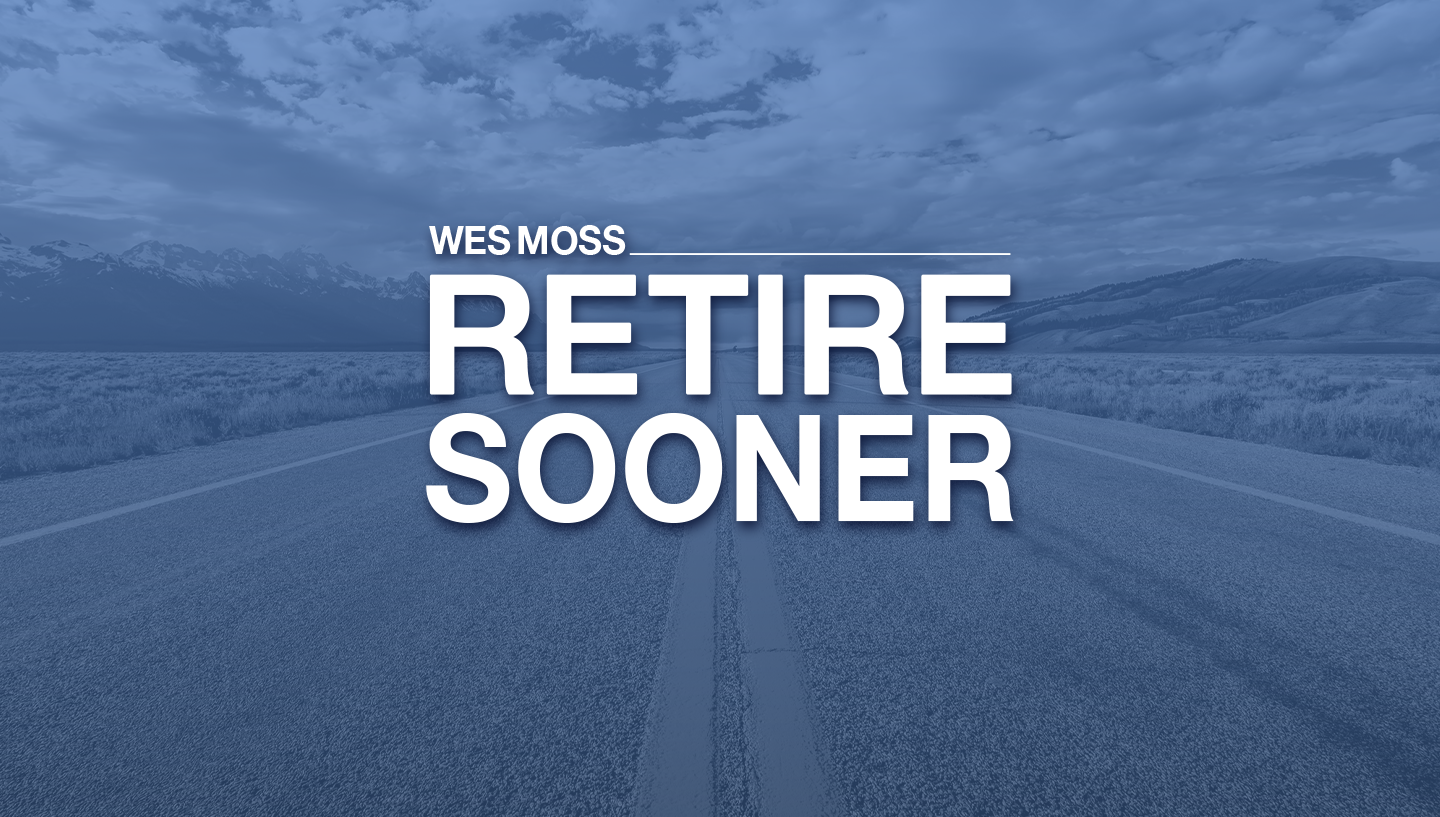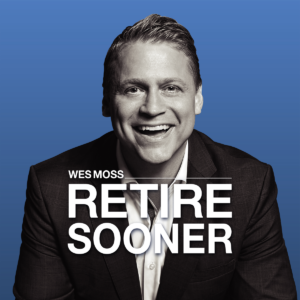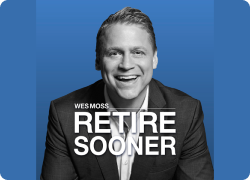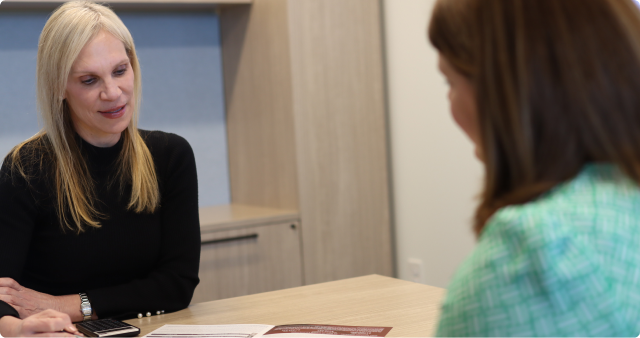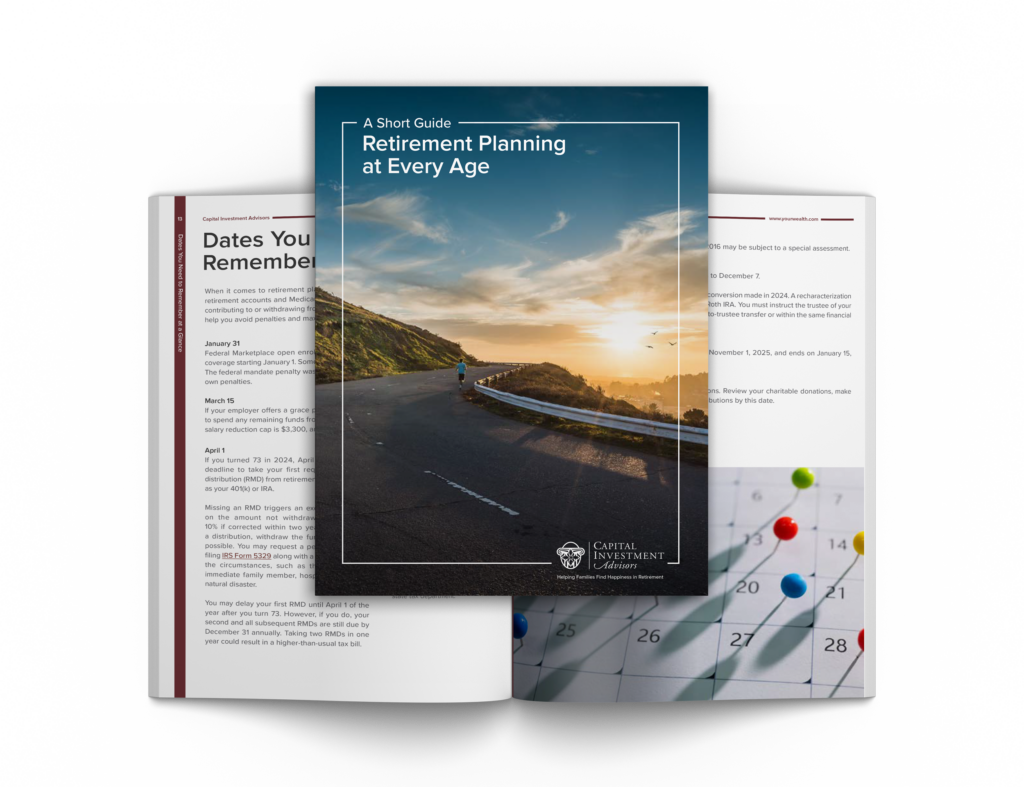Explore ways fear can sometimes subside in financial markets. Examine how missing the worst days, not just the best ones, can lead to less productive gains over time.
Wes and Christa analyze:
-
Why 2025’s market feels more like a “bungee cord” than a rollercoaster.
-
How to use the VIX (fear index) to gauge investor sentiment—and what it could mean for your investments.
-
What historical spikes in fear (dot-com crash, 9/11, the 2008 financial crisis, COVID-19, inflation shock) might teach us about recovery patterns.
-
Why most fear-filled crises eventually subside—and how to spot the turning point in hindsight.
-
How central bank interventions, Fed rate changes, and global economic actions can sometimes calm markets over time.
They answer listener questions about families, retirement, and catch-up plans, including:
-
How to save for retirement on one income with kids.
-
If you have to take RMDs at 72 while still working. (Hint: You might not have to!).
-
Why it’s okay for some to tap into their Roth IRA at age 80—and how to optimize account usage.
-
How much a married couple need to cover basic expenses in retirement.
-
How ETF providers profit when fees are so low.
-
Revenue streams, plus the Costco hot dog strategy (yep, that’s a thing!).
-
Elder Care and Safe Spending Tools.
Overall, Wes reminds folks that discipline usually means staying the course, because fear doesn’t last forever, and markets typically recover.
Don’t just listen—act! Subscribe to the Retire Sooner Podcast, share it with a friend, and take one step closer to your happy retirement. Call 800-805-6301 to leave a voicemail or contact us HERE for a chance to have your question featured in an upcoming episode.
Read The Full Transcript From This Episode
(click below to expand and read the full interview)
- Wes Moss [00:00:04]:
I’m Wes Moss. The prevailing thought in America is that you’ll never have enough money and it’s almost impossible to retire early. Actually, I think the opposite is true. For more than 20 years I’ve been researching, studying and advising American families, including those who started late, on how to retire sooner and happier. Now I’m bringing in my good friend Christa DiBiase, who has worked closely with Clark Howard for many years now to answer your questions and explore what makes a happy and fulfilling retirement. My mission on the Retire Sooner podcast is to help a million people retire earlier while enjoying the adventure along the way. I’d love for you to be one of them. Let’s get started.Wes Moss [00:00:51]:
Wes Moss along in studio with Christa DiBiase.Christa DiBiase [00:00:55]:
Christa, I am so happy to be here. West Today we’re going to talk about fear. I would say is the main, it’s.Wes Moss [00:01:02]:
An uplifting version of fear.Christa DiBiase [00:01:04]:
Yeah. There’s so many good side of fear. Yeah. The fears around the stock market and you’ve got a couple interesting topics around that I would say.Wes Moss [00:01:11]:
They’re of course they’re interesting. Yeah. I mean, thinking a long time about what to talk about today. And I think about this in, in the swirl that we’ve been in in 2025 where the stock market has been, it’s still almost, not even in the roller coaster phase. It’s still in the, it’s still, I don’t, I don’t know if we talked about this last week, but it’s more in the bungee cord phase where you have these really big drops, but then we have these really big gains. I mean, thousand point days in the Dow have been almost normal in 2025. So I, we’re not really even in the roller coaster phase. Remember we had a couple of years that were more like the escalator phase.Wes Moss [00:01:49]:
That’s the one everybody loves. The escalators is the market that everyone loves and you kind of forget that there are big drops. But we had a couple years where just steadily higher down 2,3%. But 2025 has been a year full of volatility. And we’re going to talk about the vix. The VIX is the fear index and we can watch in any given day what that level is. It’s its own index. And when we have an escalator year, the VIX settles in at 15, 13, 14, 15 16, getting to 20, things are getting a little nerve wracking.Wes Moss [00:02:23]:
And then when it gets above 2025, 30, you’re getting into a little bit of investor panic. So the VIX is a measure of people buying safety to protect their market from their portfolio from going down. So we know when the VIX is low, the world is to some extent calm and collected. When the VIX is high, that means investors are very nervous. And you usually see if the VIX is spiking, it usually means the stock market is cratering. And that’s what we’ve seen in 2025. Huge moves higher in the VIX, lower in stocks. But I go back and I pulled 10 different scenarios and I don’t know if we won’t go through all 10 of them, but I wanted to go back over the last call it 20, 25 years and look at periods of time when the VIX spiked.Wes Moss [00:03:10]:
Because all you have to do is look and see when the VIX spiked and then you can deduce, oh, that was the dot com crash. That was September of 2001. That was the 911 crash. Go back to the 90s of the Asian financial crisis crash, the global financial crisis. VIX spiked. Markets to some extent really crashed over a period of time. The COVID pandemic, the VIX spiked dramatically. Got to again, we were talking about 15 to 20 is a placid area.Wes Moss [00:03:41]:
Got over 80. It was four times the norm. And we invariably get a period of time where you have peak fear and we can nail it to a day. The VIX is the highest on this day. And that was essentially peak fear in any crisis. And then fear subsided, and then fear subsided. And it’s happened every single time. And there’s always a reason.Wes Moss [00:04:08]:
And I think of it, and it’s very easy in retrospective to know what the turning point was. I think about. It’s almost like the History Channel. You’re watching the History Channel, we’re talking about a war or crisis. And then the voice comes on and says something like, With President Kennedy’s careful yet firm handling of the Cuban missile crisis in 1962, a potential nuclear catastrophe quickly pivoted to peaceful negotiations and cold war tensions eased. And you look in retrospect and you say, oh, well, that week was really scary. And then fear subsided. And when fear subsided, or why fear subsided because commerce has prevailed and the negotiation kind of got to a resolution.Wes Moss [00:04:55]:
And it’s essentially that same pattern over and over and over again. And the VIX starts to move higher when the market gets scared, investors get nervous, and then it really peaks and then it starts to calm down. And you can only in retrospect see, well, why did we calm Down. Well, let’s go through a couple of these. And the punchline here is that we’re still in that heightened VIX phase. We may have seen the peak fear because there were a couple of days where the Vix was in the 60s. Not quite as bad as where we were in the middle of the depths of the pandemic and the peak fear of the pandemic. But we’ve already seen a really, really high spike in the VIX so far.Wes Moss [00:05:39]:
We don’t know what resolves it, Christa, but we do know at some point something will resolve it. And I think about the COVID pandemic we were announcements of everything gets canceled, we get shut in our homes, and the stock market’s dropping like a bungee cord down a roller coaster. And then we started to get the thought of, wait a minute, they’re working on vaccines. We are not going to stay locked in our homes forever. Different states started opening things back up and saying, no, you can now, you can go to the grocery store, you can go to XYZ establishment. And then fear started to subside. In retrospect, the Federal Reserve came in. The Federal Reserve came in and did huge monetary stimulus and stabilized the market.Wes Moss [00:06:27]:
So looking back, that’s why fear started to really subside. All of those, the confluence of those pieces of good news. Same thing with inflation spike and the interest rate shock in 2022. Inflation started to moderate. And we look back, we say, oh, yeah, inflation got to 9%, but then the new prints were starting to moderate. And there was a path for Americans to say, okay, we’re not going to have 10% inflation forever. European debt crisis. The European debt crisis.Wes Moss [00:06:56]:
I Remember back in 2011, we were worried that bonds all around the world weren’t going to be able to be paid by governments. That was scary. And the VIX spike, the VIX got to almost, almost 50 in 2011. That’s a really scary level. Remember, we’re over 60 already this year at one point. And then Mario Draghi, he was the chief of their European Central bank, came out and said, we will do whatever it takes and make sure that the bond market is in good shape and we’re not going to let things slip. And the plumbing’s working in the financial system. And what happened, that’s when fear stopped, subsided.Wes Moss [00:07:33]:
It doesn’t necessarily happen in a day, but you can look back and say, oh, that was the week. Mario Draghi said, whatever it takes. So we look back over time and we see Fed intervention, where the Fed comes in and Says, okay, we’ll lower rates, we’ll stabilize the financial system. We’ve seen it here in the United States, we’ve seen it in Europe. We see things like, now we’ve got better news and maybe a hopeful eye towards the future during the pandemic. But we don’t know why it gets better this time. We never know. Now you could say, well, the whole tariff issue is going to be solved and everyone’s going to get along and we’re going to do trade deals with the rest of the world and trade will come back and maybe there’s some level of tariffs, but there will be some resolution around it.Wes Moss [00:08:20]:
We just don’t know what that looks like. And we won’t until we can see it only in retrospect, but there will be a day, and maybe it’s six months from now, maybe it’s a month from now, maybe it’s a year from now, but we’ll look back and say, oh, that was the week. And, oh, that’s why fear subsided. That’s why fear subsided. And so it’s not a good bet to think we’re gonna stay in this heightened state of fear forever because history just doesn’t show that, Christa. So that’s my message today, is that we can watch the vix. We’ve had a scary year. We don’t know when it’s going to end, but you can go back over history and always point to a week or a month or a few months where, oh, that’s why things started to get better.Wes Moss [00:09:06]:
The story’s still being written, but it will have a similar resolution to the, the anxiety we’re feeling as investors right now. We just don’t know what it is just yet.Christa DiBiase [00:09:17]:
Okay, well, are you ready for some questions?Wes Moss [00:09:20]:
I am absolutely ready. Stop talking about fear and start talking about real life. How do we solve our financial questions? Happy to do so.Christa DiBiase [00:09:28]:
Okay, well, this is from Anonymous in Maryland. I’m 36.Wes Moss [00:09:31]:
We call her Annie in Anonymous.Christa DiBiase [00:09:33]:
I’m 36, earning $76,000 a year and contributing 6% to my Roth 401K. My employer matches into a traditional account 100% of the first 3% and 50% of the next 2%. I have $51,000 in my current Roth plus 52,000 in a Roth from a previous job. My husband recently took a lower paying job to support our growing family. So I am now the sole retirement saver with a combined income of 1 16K, a second child on the way, and no raises in two years, increasing my Contributions is tough. I know I’m behind on the typical 3 times salary by age 40 benchmark. What should my savings goal be? To get back on track by 67. And if I switch to a higher paying job in 1 to 2 years with a 10k to 20k bump, could that help me catch up by age 40? It would involve a longer commute which I don’t love, but I could handle when the kids are a little older.Wes Moss [00:10:26]:
So she is Anonymous Annie. Annie’s in a situation where think about your mid-30s and life is just getting more and more expensive. Right? Your 20s, it’s just not that expensive. And you can, you have roommates and you things are light and you can maybe save a little bit. Then you get your mid-30s and you have a bunch of kids and you’re trying to work and your spouse is trying to work and you have this, it just you maybe have a mortgage. Everything gets really expensive and you’re supposed to save all at the same time. So it’s a really hard period of time and it keeps getting worse. We actually reach peak spending in America in our late 40s and then it starts to come down.Wes Moss [00:11:11]:
That makes sense because our kids are typically out of college by the time we’re in our late 40s or early 50s. That’s usually peak spending. It’s everything that you have to spend normally on and some sort of college and school tuition.Christa DiBiase [00:11:24]:
Sing it. I’m in.Wes Moss [00:11:26]:
You’re in it. I’m not quite there yet, but I’m pretty close. Christa so this is a tough spot, but it’s always a tough spot. Any saving really about 10%, 6% on her own and the way her match works out, it’s about 4. So it’s really 10% and that’s actually really good. Sure, 15 would be better, 20% would be better. But the fact that you’re able to continue to do the essentially 10% six plus the four, that’s really good. If you can just keep doing that.Wes Moss [00:12:00]:
If you do the math, she’s got about a little over 100,000 saved already. If you just do some really simple math on saving that 6% plus the match, you do that for 30 years. There’s 30, she’s what, 36 or let’s call it 36 to 66. 30 years just doing that and increasing your savings, say the salary. Her salary goes up by 2% a year. So still not a huge additional savings. She still ends up with over 1 million and a half dollars at a 6. And I look at this as just a 6% rate of return.Wes Moss [00:12:37]:
So conservative rate of return, just doing the 10, essentially doing 10% because of the batch that still gets you to a million and a half dollars. And now granted, in 30 years, is that going to feel like a million and a half dollars today? No. But it’ll still be a really, really good base to be able to retire on and have an income from. There will be a time when hopefully you’re both able to work more full time. Maybe your spouse is able to get back to a slightly higher salary and then you start saving those raises. So instead of a 10 a year, maybe it’s 12 a year or 15 a year. But it is the methodical nature of doing it every single year, even when it’s really tough. Right now, when you’re in almost peak spending, you still get to a million and a half, get to 2 million, 2 and a half million depending on how much you’ve saved.Wes Moss [00:13:30]:
I’ve seen it happen over and over and over again. I think she’s on a great track.Christa DiBiase [00:13:34]:
And doing it into a Roth. That 6% that does have, that saves you on taxes later, so.Wes Moss [00:13:41]:
Saves on taxes later, absolutely.Christa DiBiase [00:13:43]:
Kathleen Oklahoma says if I’m still employed at age 72, am I required to begin taking RMDs or can I wait until I retire at 73?Wes Moss [00:13:53]:
Kathleen Mm.Christa DiBiase [00:13:55]:
Kathy.Wes Moss [00:13:55]:
Kathy okay, so there are, so now the RMD age is, remember it was 70 and a half and it started moving higher, meaning that you didn’t have to take your required minimum distributions. Remember what that’s all about? That’s the government saying, look, you saved all this money pre tax and we don’t get any revenue from it until you start pulling it out of the account and we’re going to tax it like ordinary income. That’s what RMDs are all about. It’s, hey, I want, I’m knocking on the door and saying, okay, by this age you got to start taking money out so we can collect our taxes. It’s moved up to 73, so, and it continues to move higher over the next several years, the RMD age is actually going to continue to go up. I want to say to something like age 75 out into the future. But for now, if the rule around this is that if you are still working and you’re working full time or part time and you have a company 401k, your RMDs get delayed, you don’t have to take them. So the answer is if, look, if you’re still working and you’ve got a 401k at work.Wes Moss [00:15:00]:
You don’t have to do your RMD. Now, let’s take this, Cathy, one step further. What else could you do to take advantage of the fact that you’re working at 73, which maybe you want. You want to be working, maybe you don’t. If you have other IRAs that you could consider moving those IRAs into the 401, we always think about rollovers from 401 to IRA. You could consider. There’s a lot to think about here. But imagine you had all of your retirement assets in the company 401, and you’re working.Wes Moss [00:15:31]:
Guess what? No RMDs for that period of time. So that’s just another way to think about how to use the rules to your advantage.Christa DiBiase [00:15:39]:
Okay? And then Martin in South Carolina says, my wife and I are 80 years old and planning to move into an over 55 age community. We will sell our current home to purchase a home in the new community. However, the difference between selling and purchasing will leave us with about $200,000 in shortfall. Our combined total investments are 2.5 million in our IRA, 1.4 in our Roth accounts, and 2.1 million in our taxable brokerage accounts. Which would be the best sources for us to take money for our new home purchase. Concerning taxes and additional financial points that you are aware of.Wes Moss [00:16:12]:
Okay, Martin, It’s a lot of savings.Christa DiBiase [00:16:14]:
It’s a lot.Wes Moss [00:16:14]:
He’s got a lot of savings. Two and a half million IRA 1.4, Roth, and then a million. Over a million in taxable is what I’m seeing there. Here’s my thought, is that we go. The Roth is the quick reminder on the utility of the different accounts. They’re all good, all the savings levels are good because you have cash reserves. But from a tax perspective, a regular IRA is probably the least good. Then you’ve got a taxable brokerage account, and then the next best or the slightly better and then the best, in my opinion, is the Roth tax free, no matter how much you pull out.Wes Moss [00:16:52]:
So, Martin, you have a $200,000 delta that you want to cover. We talk so much about how great the Roth is. I also noticed, Christa, that nobody ever wants to use the Roth money. It’s like, oh, I can’t take the roth. Martin, you’re 80. When are you going to use it? So this is when you use it. I’ve talked a lot about the utilization of a Roth. And if you talk to tax professionals, I’ve heard one of their Opinions is often the Roth works if you use the Roth.Wes Moss [00:17:24]:
It only works if you use it. Sure you can. It’s great for your heirs to inherit the roth because their RMDs are same thing or they don’t have RMDs and when they pull money out, it’s tax free for them too. So it’s a great asset, legacy asset too. But I think in this case, because it’s only, if you’re doing the math, 200 over 1.4 million. It’s only about 15% of the Roth. So this, I think this is the time to use it. I would wash away the guilt of using the forbidden Roth money, and this is the time to use it.Wes Moss [00:17:58]:
So you use the $200,000. You still have plenty in the Roth. 1,200,000 left versus $1,400,000. And you’ve done that. No taxes, no mortgage now. And to me, I’m giving you some permission to go ahead and at least consider using the Roth. The second best option. If you do have a taxable account and you have some positions that don’t have big gains, you can focus in on those positions, turn that into cash and use that as well.Wes Moss [00:18:23]:
That’d be my second option. But I like the Roth option. When we get back, I want to talk about. There’s lots of talk about missing the best days in the market. And of course, we don’t want to miss the best days, but we tend to think, well, it would be nice to miss the worst days too. Wouldn’t that be nice? So we did some research around trying to hop out between the raindrops and miss the worst days. But the math on that actually gets really interesting as well and the ability to even do that. So I want to talk about those numbers when we get back.Wes Moss [00:18:54]:
Are you facing a fork in the road and deciding between continuing your career and retirement? I’m Wes Moss and this massive life decision shouldn’t be taken lightly. Talk with my team. If you’d like help reviewing your retirement accounts and building a financial plan, we can help you review options and offer an opinion based on your best interests. You can find us at YourWealth.com that’s Y-O-U R Wealth.com are you ready to go into market timing?Christa DiBiase [00:19:26]:
Let’s do it. And then I do have some more questions from you.Wes Moss [00:19:29]:
I’m excited to get questions. The reason I wanted to talk about this today is that I hear about this a lot. I would think our listeners have heard these statistics. I’ve obviously talked about it here on the show. It’s almost become, maybe this is just me because I’ve talked about this a lot, but after hearing about it and reading about it a lot over the past month, you hear about the adage of if you miss the best days, your rate of return goes down a bunch. It’s just a few of the best days. So if you’ve missed just 10 of the best stock market days over a 30 year stretch and what happens, your rate of return drops in half. I mean, and that makes sense, right? You’re missing out on gains.Wes Moss [00:20:08]:
And really what you’re doing is you’re missing out on rebounds. So the next iteration of that is, what if I were to just miss the worst days? What if I were to get out when markets were dropping? Well, of course that works really well. So if you miss the. Again, you take a 30 year stretch, 1995 to 2005, you’ll see that, that overall rate of return, and we just did this research as of, I want to say, last month, average rate of return, 8.3% for S&P 500, fully invested. But if you miss just five of the worst days in 30 years, your rate of return jumps to 10. So it works. Of course it works. If you miss 20 of the worst days in the market, your rate of return on average jumps almost 14%.Wes Moss [00:20:57]:
I think that is of course, why we have the inclination to try to dance between the raindrops and get out before. Before markets drop.Christa DiBiase [00:21:06]:
Sure.Wes Moss [00:21:07]:
So it intuitively makes sense and then mathematically it makes a lot of sense. You miss bad days and your overall rate of return goes. Goes through the roof. The problem with that and the reality check around that is that here, and this is, if you look at a chart, you’ll see that almost all the, the rebound days are almost touching historically, right. At this very similar rate of time as the worst days, the rebounds come after the worst days. Then you get rebounds and you get terrible days again. And we’re kind of in one of those cycles right now. But if you look mathematically, 80% of the 50 best days in the market, this is over 30 years.Wes Moss [00:21:47]:
So 80% of them happen within just one month of the worst days. So they’re all really close together. And I think we’re in, we’re in one of those periods of time. Terrible days. Great days. Terrible. Great. So the reality is that if we’re looking at trying to get and miss the worst days, which intuitively makes total sense, then we almost invariably miss the good days as well, we miss the rebound days.Wes Moss [00:22:12]:
So it’s not even really. I would say it’s, I don’t know, I guess nothing is impossible, but I would say it’s virtually impossible, Christa, to be able to do that. So what if you were to miss. There’s some more math and history. If you were able to sidestep just the really volatile period, so you miss the best days and the worst days. You say, I know I can’t time worst and best, so I’m just going to miss those really shaky periods and just be invested. When things are maybe to escalator mode. We talk about 2022 or 2023 and 24 were kind of escalator years.Wes Moss [00:22:46]:
What’s interesting about that, if you do the math, that doesn’t really work all that well either. So if you’re fully invested over that same period of time, this is 95 through April of 2025, fully invested, 8.3%. You miss the 10 best days and you get to sidestep 10 of the worst days. It’s 20 days. You’re, you’re out of volatility. Your long term rate of return only goes up to 8.5. So you get from 8.3 to 8.5 and you’re doing something that’s virtually impossible to begin with, but it doesn’t really help anyway. So the point here is that because we’re not able to time it perfectly, even if we get out of these volatile periods, we still don’t really gain a whole lot of ground.Wes Moss [00:23:32]:
Just another way, I think, to look at the reality of how we need to invest, which is not trying to time, it’s timing and being in invested over time, taking our lumps when things are bad, but then enjoying the fruits of staying patient, staying objective, believing in the future. I think of happy. One thing I believe very strongly of happy retirees is that happy retirees are tomorrow investors. They’ve got us a general. They’re not unrealistic, but they have a general sense of optimism. And I think that helps us get through these tough times. Like we’re kind of in right now for markets. But tomorrow investors aren’t worried about what’s actually happening tomorrow.Wes Moss [00:24:15]:
They’re looking way out into the future. That’s why I call them tomorrow investors.Christa DiBiase [00:24:19]:
I love it. Okay, we’ll go to questions when you. And this one’s from Andrew in Iowa. ETFs are great for us as investors, but how do they benefit the institution that issues them? Especially now that asset fees are incredibly low on most ETFs, I’m confused what the motivation would be for creating and issuing that product. Do those tiny asset fees really make them that much money across the whole market? Or are they just sharing different investment options out of the goodness of their hearts? Or is there some other way they’re profiting? Thank you for all your investing insight.Wes Moss [00:24:51]:
So Andrew, that’s kind of a cool question. I’ve never had that before. So I’m thinking about this a little bit now. Now some companies I think about a Vanguard, they are really mutual, they’re mutually owned. So they it’s not a nonprofit. I think it’s different than a nonprofit. But the bigger they’ve gotten, the more they’ve been able to lower their fees. But besides them, let’s look at the reality of the world.Wes Moss [00:25:12]:
Think of the big ETF providers, BlackRock, they own iShares and State Street. I think the brand of ETFs they have are spiders. And think Fidelity, Schwab, all these giant companies, these are for profit companies. And you’re right, trading fees have essentially gone away. And now ETF fees are so small that I’ve thought the same thing. Like at some point, if you’re charging point 0.0, so there’s 1% and then there’s 0.1% and then there’s 01%. Like how do you make any money doing that? Here’s the math at 0.03%. So again, a third of a tenth of a percent.Wes Moss [00:25:57]:
Christa, ultra, ultra cheap. At $100 billion, it’s still $30 million a year.Christa DiBiase [00:26:05]:
Not too shabby.Wes Moss [00:26:06]:
It’s all about scale. These companies don’t have hundreds of millions and they don’t have tens of billions. They have hundreds of billions. In in the case of the really big asset managers under management for some of the top five, they have multi trillions. So it is a game of scale. And I think that’s part of the reason we, we’ve been able to see rates and expenses come down because these companies have gotten so big. So first it’s so much about scale. Secondly, there is a kind of a hidden revenue stream.Wes Moss [00:26:44]:
It shouldn’t be costing you the investor, but they if an institution owns a bunch of stocks in an etf, they can do securities lending on that. So that’s another hidden way they make some money. There is something called creation and redemption fees. So think about the complexity of an ETF that owns 500 stocks and it stays almost perfectly at what the index. Not exactly perfectly, but very close to where the index is there’s a lot that goes on behind the scenes. So there’s something called authorized participants that handle the buying, the selling of, of some of the positions within the ETFs. And the providers make money that way too. But I would look at it, and the cousin to scale is the concept of kind of loss leading.Wes Moss [00:27:29]:
What’s a loss leader it would be doing. Maybe this is a bad example, but Costco’s $50 hot dog, that’s a great example. That’s a loss leader.Christa DiBiase [00:27:38]:
That’s the ultimate loss leader. Yeah.Wes Moss [00:27:40]:
Okay, so it is.Christa DiBiase [00:27:40]:
You’re getting people in the door with something you lose money on.Wes Moss [00:27:43]:
Obviously Costco’s not making any money on a $50 hot dog plus Coke. But if one out of 100 people make the midday decision of, hey, I’ll go get my $50 lunch and you end up buying a flat screen TV or a bar of gold at Costco, which you do now too. Sure.Christa DiBiase [00:28:02]:
50 packs of toilet paper like I do that 50. No, you can only get two giant packs at a time actually when they’re on sale. But I’ll go multiple times.Wes Moss [00:28:11]:
So they take a little bit of a loss. Maybe they lose a dollar on selling that lunch, but they make 20 bucks selling a TV. And that I also think is all the other services. Remember the big ETF providers, if you look at the scope of their full business, they do way more than just ETFs. They do mutual funds that have, they do have higher fees. They’ll do other ETFs that have higher fees. They’ll do brokerage accounts, let securities lending and that full suite of services they’re going to have higher margins on typically. So I think of these ultra low fees as kind of a Costco hot dog.Wes Moss [00:28:49]:
Okay, boss, leader trick.Christa DiBiase [00:28:51]:
This is from Laura in Georgia. Hi, Wes. My husband and I both work full time, but due to medical reasons, we’re planning to retire in the next year or two. I’m 63, he’s 77 and already receiving Social Security. We’ve paid off over $100,000 in debt and have $250,000 saved in a traditional IRAs and 401K, which is no longer Roth. With uncertain markets and only needing about 20k a year to live on. If Social Security remains intact, how much should we move to cash or liquid assets? When should we do it and where should we put it for safekeeping to cover our bills? Love you guys.Wes Moss [00:29:24]:
Love you too. Laura.Christa DiBiase [00:29:25]:
Yes.Wes Moss [00:29:25]:
I love these. Our listener really are very sweet. So we’ve gotten a lot of very nice notes. So I very much appreciate.Christa DiBiase [00:29:32]:
Yes, absolutely.Wes Moss [00:29:33]:
We are trying to help and our answers here are we’re doing the best we can do and they’re not necessarily the perfect answer. But I think hopefully the guidance is helping. So Laura, the, the perspective I would have here is first of all you mentioned if it was casual, but you said if Social Security is there, you’re 63, your husband’s 77. Social Security will be there. It’s not going away and it’s easy to scare people that it’s going to go away, but it’s not going away, particularly for somebody in their 60s and above. It’ll get maybe reduced for the 20 year olds you’re not. I would be careful if I was a 20 year old counting on what today would be a full, full, full Social Security payment. That’s probably a question, but that’s a really long time.Wes Moss [00:30:26]:
We’re talking 30, 40, 50 years from now for you guys, Social Security is going to be there. So if that’s the case and you only need 20k a year from the portfolio, well, what’s the dry powder rule? Five years, let’s call it of. And it could be anything but I kind of benchmark it at three years at least. Let’s push it to five for you. Simple math. Five years of spending 20K is 100K. So I would have. Of the 150, 100 of the two.Wes Moss [00:30:55]:
I’m sorry, of your 250. 100 of the 250, which is only 40% in the dry powder areas, which would be CDs, a money market mutual fund, a shorter term treasury fund or even a short to intermediate term treasury fund that is going to have some movement because bond prices do move if they’re not ultra short term. But to me those are all the areas, Laura, that you want to keep. 40ish percent in that dry powder and then for utility purposes, cash, cash, cash. Not invested actually in a checking account. Six months to a year just so you’re not having to sell something. So that’s another 10 or 20 in just a regular checking account. Usually you don’t get a lot of interest in those in the world we live in today.Wes Moss [00:31:44]:
But I think that takes care of 5 years dry powder safety assets and the really short term, six to 12 months of just utility money. That’s why I would do it.Christa DiBiase [00:31:54]:
All right, this next question is from Cheryl in Texas. What is the best way to give an elderly parent who is moving to assisted living soon a small amount of funds, cash or credit, or debit weekly for things like light shopping and snacks, bingo, small fee events, et cetera, and do so without giving them full access to their entire bank account. And also, is there a way to track what they spend it on? If there is a way, then that would be a bonus.Wes Moss [00:32:19]:
Cheryl brings up a really good point. So think about if you’re in your 20s, your parents are still probably in their 40s or 50s, so this doesn’t register. Well, of course, mom and dad, they can deal with their own cards. But if you are 50 and your parents are 80 or 90 and it’s harder for them to maybe see and technology’s confusing and they’re susceptible to a text message or one of these phishing scams where somebody ultimately gets access to an account, you do need to be worried and careful about having, let’s say a big, big brokerage account or savings account tied to a card or checking because you can really leave the door wide open. So what Cheryl’s thinking about here is how do you just siphon off enough for them to use and not be tied to the bigger accounts? And I think that’s a super smart.Christa DiBiase [00:33:14]:
Kind of like a question we will get about people trying to, you know, give their teens money to spend or their smaller kids not giving them full access, but how do they give them.Wes Moss [00:33:23]:
Exactly.Christa DiBiase [00:33:24]:
Yeah.Wes Moss [00:33:24]:
And for a similar. Sometimes the same reason or a similar reason. So which I’ve used the green light card as an example with my kids. So you essentially need a green light card for your parents. And I think this simple answer right out of the gate is just. And this, I guess it’s a little harder to track where all the money’s going. It’s just a prepaid debit card. So every single month you give mom and dad a prepaid debit card.Wes Moss [00:33:48]:
It’s got $1,000 on it or 2,000. And that takes care of all the spending they need to do in a given month and it’s not linked to anything else, so you’ve got some protection there. There’s a couple other companies though, that I want you to check out. Full disclosure, I have not used some of these. So I want you to read about them and research about them. But the Trulink card is really designed, I’ve read about this. Designed for kind of like a green light card for your parents and for seniors and for caregivers to solve this very problem. So I would check that out.Wes Moss [00:34:24]:
Also, there are again, prepaid cards. There’s netspend, there’s Bluebird by Amex. Those are all options for you to consider. But I think the bigger point here, Chris, is just like, we don’t want our kids to have a card tied to a video game where they can spend, you know, $1,000 or $5,000 on virtual coins. We want to protect our seniors as a caregiver, really more from a. From fraudsters and bad actors. So.Christa DiBiase [00:34:55]:
And I would also say, Cheryl, if you. I assume that you have fiduciary financial power of attorney, and if you have that, and you have. They have a credit card, most cards allow you to set daily spending limits on them and also or checking accounts. If it’s a debit card, you can set a daily limit on the debit card. If the parents don’t have access to that and they can’t change it and you have that power of attorney, that might be an option, too. And you can look in the account and see what it’s spent on.Wes Moss [00:35:23]:
Yeah, I think it’s a really good point. So when mom and dad are declining and your parents are worried that they’re going to be taken advantage of, that’s the time when the siblings or the adult children really do want to step in. Maybe you start by just getting access to see their accounts and then you take the next step, which is a power of attorney on the financial accounts, to really monitor it for them. So that’s a really. That’s a really good point. Chris. I love having you here. I love these questions.Wes Moss [00:35:53]:
So thank you, as always, for being in studio. Send us more questions@yourwealth.com contact. Have a wonderful rest of your day.Mallory [00:36:04]:
Hey, y’all, this is Mallory with the Retire Sooner team. Please be sure to rate and subscribe to this podcast and share it with a friend. If you have any questions, you can find us@wesmoss.com that’s w e s m o s s dot com. You can also follow us on Instagram and YouTube. You’ll find us under the handle Retire Sooner podcast. And now for our show’s disclosure. This is provided as a resource for informational purposes and is not to be viewed as investment advice or recommendations. This information is being presented without consideration of the investment objectives, risk tolerance or financial circumstances of any specific investor and might not be suitable for all investors.Mallory [00:36:41]:
The mention of any company is provided to you for informational purposes and as an example only and is not to be considered investment advice or recommendation or an endorsement of any particular company. Past performance is not indicative of future results. Investing involves risk, including possible loss of principal. There is no guarantee offered that investment, return, yield, or performance will be achieved. The information provided is strictly an opinion and for informational purposes only, and it is not known whether the strategies will be successful. There are many aspects and criteria that must be examined and considered before investing. This information is not intended to and should not form a primary basis for any investment decision that you may make. Always consult your own legal tax or investment advisor before making any investment, tax, estate or financial planning considerations or decisions.Mallory [00:37:26]:
Investment decisions should not be made solely based on information contained herein.
Call in with your financial questions for our team to answer: 800-805-6301
Join other happy retirees on our Retire Sooner Facebook Group: https://www.facebook.com/groups/retiresoonerpodcast
This information is provided to you as a resource for educational purposes and as an example only and is not to be considered investment advice or recommendation or an endorsement of any particular security. Investing involves risk, including the possible loss of principal. There is no guarantee offered that investment return, yield, or performance will be achieved. There will be periods of performance fluctuations, including periods of negative returns and periods where dividends will not be paid. Past performance is not indicative of future results when considering any investment vehicle. The mention of any specific security should not be inferred as having been successful or responsible for any investor achieving their investment goals. Additionally, the mention of any specific security is not to infer investment success of the security or of any portfolio. A reader may request a list of all recommendations made by Capital Investment Advisors within the immediately preceding period of one year upon written request to Capital Investment Advisors. It is not known whether any investor holding the mentioned securities have achieved their investment goals or experienced appreciation of their portfolio. This information is being presented without consideration of the investment objectives, risk tolerance, or financial circumstances of any specific investor and might not be suitable for all investors. This information is not intended to, and should not, form a primary basis for any investment decision that you may make. Always consult your own legal, tax, or investment advisor before making any investment/tax/estate/financial planning considerations or decisions.

